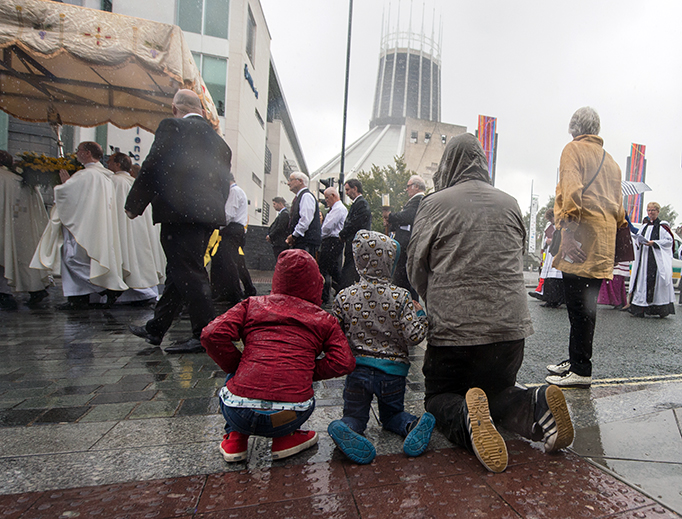A Remarkable Thing Just Happened in Liverpool, England
Sunday’s event was the largest Catholic procession in England since Pope St. John Paul II's visit to Britain in 1982.

Last Sunday through the rain they walked.
Approximately 10,000 people gathered for the largest Catholic procession in England since Pope John Paul II's visit to Britain in 1982. This was the culminating act of the 2018 Eucharistic Congress then taking place in Liverpool.
This was a Eucharistic procession with a difference though.
On English streets it was a very public act of worship — an act of faith in the Body, Blood, Soul and Divinity of Christ.
The procession comes at a time when the Church of Christ is in the grip of a purification as painful as it is necessary.
The English rain and gray skies were, therefore, appropriate. For this was a trail of tears walked alongside the One who is crucified anew in the bodies of the innocents preyed upon and wounded by those who bear the name Christian and yet, by their actions, make sacrifice to a very different master.
The Cardinal Archbishop of Westminster Vincent Nichols told those taking part in the procession that it was undertaken in a spirit of “prayer and penance …[without] one iota of pride or triumphalism in our steps…In many ways, ours is a penitential procession for we are focused on Jesus Christ, who we have crucified…Today I come as a beggar seeking forgiveness laying the load, hurt, damage and mistrust we have caused at the foot of the Cross.”
This was to be a procession with only one destination in view: Golgotha.
# # # # # # #
The first Eucharistic Congress took place in England in 1908. For a religion that had been crushed, persecuted, and then finally tolerated in that land, this was a revolutionary act. Needless to say it met with much opposition. The Congress organizers at the time were keen to have a Eucharistic procession through the streets of London. This was to prove too much for the four-centuries-old Protestant Establishment.
As the possibility of a Eucharistic Procession was being discussed, The Spectator on Sept. 12, 1908, noted the concerns then felt throughout London, writing with some sympathy for the Catholic procession proposed:
“The solemn closing of the Congress on Sunday afternoon is to be marked by a ‘Great Procession of the Blessed Sacrament’, which is to follow the celebration of Pontifical vespers and to precede the Te Deum and Benediction. The route has been carefully chosen in the quieter streets round Westminster Cathedral, and has received the approval of the police authorities. Unfortunately, however, such a procession ‘falls within the mischief’ of the 26th section of the Catholic Emancipation Act, which subjects all persons taking part in it to a substantial fine. The Protestant societies are up in arms, are appealing to the Sovereign to forbid it by Proclamation, and are calling upon the Ministry and upon the head of the Metropolitan Police to enforce the statute. The law is the law, and we do not deny that it is on the side of the protest. But the Protestant position is so safe in this country, so deep-rooted in the convictions of the people, that we should deeply regret open unpleasantness in the streets, not only as a discourtesy to our visitors, but as something like a declaration of weakness —a distrust in our great tradition of toleration.”
For all the talk of “toleration,” the Eucharistic procession did not, in the end, go ahead. The government put pressure on the then-Cardinal Archbishop, Francis Bourne, who reluctantly canceled the procession.
And yet, Catholics still processed through the streets of Westminster, albeit without their Eucharistic Lord. Members of religious orders in ordinary garb carried their habits (which they were not allowed by law to wear) in silent protest. England’s Catholics processed and gave witness and, even if the Blessed Sacrament was absent, another Body of Christ was made visible. That procession proved a fitting tribute to the generations who had held to the ancient faith despite the eradication of the Catholic Church from public life and the later hostility of the civil authorities.
In some ways, this 1908 London rejection of the Body of Our Lord was closer to that witnessed 19 centuries earlier in another city where red were the wounds from which his blood flowed.
# # # # # # #
In today’s Britain, Eucharistic processions are permitted.
On the feast of Corpus Christi this year, I walked through London’s streets while a monstrance containing the Host was held aloft. There was little reaction to this, however. The crowds simply passed Him by. These 21st-century Londoners, busy shopping and sightseeing, would not have hurt Our Lord, only passed Him on the street, for seemingly most no longer recognise — or even care — who he is.
Last weekend, it was right that Catholics walked in a spirit of penance with the Blessed Sacrament through the streets of Liverpool. It is the right response to the wounds inflicted afresh upon his sacred body. Perhaps, it is the only response, and one that should be replicated in city streets and country lanes throughout all of Christendom, for this latest bitter trial leads us either to accompany Our Lord to Calvary or into an empty abyss from which there is no return.
Therefore, as, even yet, the skies darken around us, with Our Lady of Sorrows by our side we struggle on, with eyes fixed on His bloodied figure, while carrying what has been laid upon us — namely, the Holy Cross.














